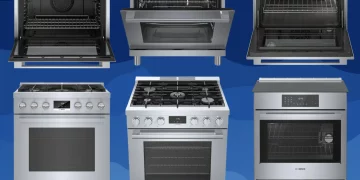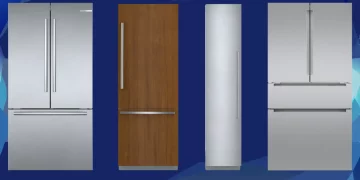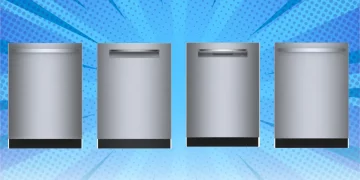Hey everyone, it’s Kathy here with our take on induction cooktops after extensively researching customer experiences and testing the appliances firsthand. We cut through the buzz and give you the unbiased lowdown so you can determine if induction is right for your kitchen. Grab a snack, because we’re about to dive deep.
Honorable Mentions
Two more models deserve shoutouts:
GE ProfileTM 36”
The GE ProfileTM 36” premium GE induction cooktop would have snatched a top five spot, but its steep $2443 price tag and lack of smart features couldn’t match the Bosch’s superiority. Still a stellar performer.
Samsung 30”
The Samsung 30” is well-reviewed and full-featured, but it is relatively standard compared to the other cutting-edge options in the top five. Still, it is a solid choice for induction beginners.
Why Go Induction?
In a nutshell, induction cooking uses magnetic fields to heat pans directly instead of thermal heat sources like electric coils or gas flames. This makes induction:
Ultra quick
You can boil a liter of water in under 3 minutes!
Energy efficient
Up to 90% of energy goes directly to heating pans.
Precise
Temperature can be adjusted in increments of 10 degrees.
Seamless
Smooth glass surface makes cleaning a breeze. Induction brings cooking into the 21st century with its speed, safety and tech-forward capabilities.
Safe
The surface only heats pans so stays much cooler. However, it has some downsides to consider.
You Shouldn’t Go Induction If…
Growing Pains
After testing induction across our product team, a few disadvantages stood out:
Some Noise and Vibration
A minor annoyance was the audible humming and vibrating sensations during cooking caused by the magnetic induction process. Newer models minimize these effects, but some noise is intrinsic to the technology. Heavier pans occasionally scratch against the glass surface, especially when sliding on and off the cooktop. While scratches are purely aesthetic and don’t impact cooking, it’s something to consider, given the steep induction costs. Proper cookware compatible with your induction model minimizes unwanted sounds and surface abrasions.
Learning Curve
Switching from gas or electric means rethinking simmering, searing, and more. Since induction doesn’t heat the air, there are no visible flames or red glow to gauge heat levels. You have to rely on digital displays. It takes practice adapting flame-reliant techniques. For example, nearly burning multiple dishes taught me to lower the heat on induction several minutes before the desired final simmer temp. And without the flames, I found it trickier to eyeball the perfect spot for griddling veggies and proteins. But after a few weeks adjusting, I had pan temps and timing down pat. Just anticipate a bit of a learning curve.
Upfront Costs
Induction cooktops have higher upfront costs, ranging from $800 to over $3000. Unless your existing set is stainless steel or cast iron, you’ll also likely need new cookware compatible with induction. Replacing my old electric range with an induction range meant over $2000 in upfront costs. However, long-term energy savings can offset the initial spending. Just be prepared for the investment. Alright, now that we’ve covered the key pros and cons, let’s move on to the top models!
How to Choose an Induction Cooktop
With so many options on the market, how do you decide which induction cooktop is right for your home? Here are my top tips for picking the perfect model:
Size
First, think about size—how big are your pans, and how much cooking space do you need? If you regularly cook large meals, 36″ cooktops give you four burner zones to accommodate multiple pots on the go. But for smaller kitchens, 30″ cooktops will do just fine for everyday demands.
Cooking Style
Next, consider your cooking style – are you a gadget geek who loves home automation? Look for WiFi connectivity and app controls. Do you have a young family with safety concerns? Opt for keypad locks and cool-touch surfaces. If you’re a culinary artist, precise pro-style controls should be your priority. Match the features to how you cook!
Budget
And don’t forget your budget! While induction typically costs more upfront, prices range from under $1000 to over $3000. Know how much you can spend – you can get great performance without blowing the budget. For instance, my neighbor Janette went with the Frigidaire 30″ to save money for her kitchen reno. It’s been meeting her needs beautifully.
Installation, Ventilation and Service
Installing induction sounds intimidating, but it’s comparable to a standard electric cooktop. However, you may need an electrician to adapt your power supply to a 240V circuit – induction requires more voltage. Proper ventilation is also a must, even without actual flames! Induction still produces smoke, grease, and odors that require overhead ventilation. I always recommend incorporating powerful 400+ CFM hood fans when installing induction. And don’t forget the yearly service! Like all appliances, induction cooktops need TLC. Schedule annual tune-ups to keep your cooktop running in tip-top shape. During service visits here at Masters, our techs check all internal components and update software/firmware. Well-maintained induction can last over a decade!
What About Rebates for Induction Cooktops?
Here’s some exciting news: Many states and utility companies offer rebates of up to $500 for installing ENERGY STAR-certified induction cooktops! For example, residents in Massachusetts can earn up to $500 back from MassSave when purchasing qualifying induction models. My neighbor Sunita got $400 back after her Miele induction installation, thanks to her utility company rebate! Contact your state or local utility to ask about induction cooktop incentives and rebates. Every little bit helps offset the upfront costs. Plus, you’ll continue saving for years with induction’s energy-efficient cooking. Rebates are just the icing on the (energy-saving) cake!
What Cookware is Best for Induction?
Induction works by inducing a magnetic field in cookware, so your pots and pans need the right makeup. Stainless steel and cast iron are ideal for induction, but some aluminum and copper cookware can also work if specifically labeled “induction ready.” Avoid plain ceramic, glass, copper, or aluminum pans—induction will not engage with these materials. Test your existing cookware by placing it on an active induction zone—if it heats up, you’re good to go! If your cookware is incompatible, I recommend investing in new stainless steel induction-ready pots and pans. Quality cookware maximizes the performance and durability of your cooktop. For optimal results, I suggest sticking to reputable brands like All-Clad, Cuisinart, and Scanpan.
Care and Maintenance
While induction surfaces seem futuristic, care and cleaning are low-tech. Since no coils or gas flames exist, very little maintenance is required. Avoid abrasive scouring pads; use a ceramic cooktop cleaner, and you’re set! I recommend daily wiping with a soft cloth or paper towel after cooking to prevent mineral deposits from forming on the surface. Be sure to read the product manual for your model’s specific care guidance. Overall, the induction needs basic cleaning; no heavy lifting is required! As for longevity, induction cooktops can run smoothly for over a decade when properly maintained and serviced. Get ready to enjoy the ease and convenience of induction cooking for many happy years to come!
FAQs – Buyer Guidance
To wrap things up, here are some frequently asked questions I get from induction shoppers:
What cookware is compatible?
Look for stainless steel and cast iron. Some aluminum and copper alloys may also work if marked ‘induction ready’. Avoid plain ceramic and glass.
Do I need new cookware?
Possibly. Test your existing pans to see if they adhere to the cooktop. Stainless and cast iron are usually safe bets.
How durable is the glass surface?
Very – scratches are mainly cosmetic and don’t impact cooking ability. Avoid abrasive scouring pads and use gentle cooktop cleansers.
How difficult is installation?
Installation is comparable to that of a standard electric cooktop. However, if your power supply is not already compatible, you may need an electrician’s help adapting it to 240V. There we have it friends – my complete guide to conquering the world of induction cooktops. Hopefully this review gave you some clarity in your research. Feel free to reach out with any other questions. Pretty proud of the finished product: Happy cooking!










